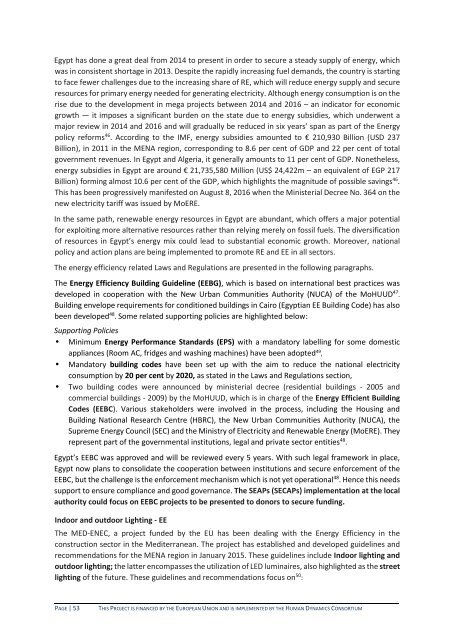180917_CES-MED_National_Report_Egypt_FINAL2rev
You also want an ePaper? Increase the reach of your titles
YUMPU automatically turns print PDFs into web optimized ePapers that Google loves.
<strong>Egypt</strong> has done a great deal from 2014 to present in order to secure a steady supply of energy, which<br />
was in consistent shortage in 2013. Despite the rapidly increasing fuel demands, the country is starting<br />
to face fewer challenges due to the increasing share of RE, which will reduce energy supply and secure<br />
resources for primary energy needed for generating electricity. Although energy consumption is on the<br />
rise due to the development in mega projects between 2014 and 2016 – an indicator for economic<br />
growth — it imposes a significant burden on the state due to energy subsidies, which underwent a<br />
major review in 2014 and 2016 and will gradually be reduced in six years’ span as part of the Energy<br />
policy reforms 46 . According to the IMF, energy subsidies amounted to € 210,930 Billion (USD 237<br />
Billion), in 2011 in the MENA region, corresponding to 8.6 per cent of GDP and 22 per cent of total<br />
government revenues. In <strong>Egypt</strong> and Algeria, it generally amounts to 11 per cent of GDP. Nonetheless,<br />
energy subsidies in <strong>Egypt</strong> are around € 21,735,580 Million (US$ 24,422m – an equivalent of EGP 217<br />
Billion) forming almost 10.6 per cent of the GDP, which highlights the magnitude of possible savings 46 .<br />
This has been progressively manifested on August 8, 2016 when the Ministerial Decree No. 364 on the<br />
new electricity tariff was issued by MoERE.<br />
In the same path, renewable energy resources in <strong>Egypt</strong> are abundant, which offers a major potential<br />
for exploiting more alternative resources rather than relying merely on fossil fuels. The diversification<br />
of resources in <strong>Egypt</strong>’s energy mix could lead to substantial economic growth. Moreover, national<br />
policy and action plans are being implemented to promote RE and EE in all sectors.<br />
The energy efficiency related Laws and Regulations are presented in the following paragraphs.<br />
The Energy Efficiency Building Guideline (EEBG), which is based on international best practices was<br />
developed in cooperation with the New Urban Communities Authority (NUCA) of the MoHUUD 47 .<br />
Building envelope requirements for conditioned buildings in Cairo (<strong>Egypt</strong>ian EE Building Code) has also<br />
been developed 48 . Some related supporting policies are highlighted below:<br />
Supporting Policies<br />
• Minimum Energy Performance Standards (EPS) with a mandatory labelling for some domestic<br />
appliances (Room AC, fridges and washing machines) have been adopted 49 ,<br />
• Mandatory building codes have been set up with the aim to reduce the national electricity<br />
consumption by 20 per cent by 2020, as stated in the Laws and Regulations section,<br />
• Two building codes were announced by ministerial decree (residential buildings - 2005 and<br />
commercial buildings - 2009) by the MoHUUD, which is in charge of the Energy Efficient Building<br />
Codes (EEBC). Various stakeholders were involved in the process, including the Housing and<br />
Building <strong>National</strong> Research Centre (HBRC), the New Urban Communities Authority (NUCA), the<br />
Supreme Energy Council (SEC) and the Ministry of Electricity and Renewable Energy (MoERE). They<br />
represent part of the governmental institutions, legal and private sector entities 48 .<br />
<strong>Egypt</strong>’s EEBC was approved and will be reviewed every 5 years. With such legal framework in place,<br />
<strong>Egypt</strong> now plans to consolidate the cooperation between institutions and secure enforcement of the<br />
EEBC, but the challenge is the enforcement mechanism which is not yet operational 48 . Hence this needs<br />
support to ensure compliance and good governance. The SEAPs (SECAPs) implementation at the local<br />
authority could focus on EEBC projects to be presented to donors to secure funding.<br />
Indoor and outdoor Lighting - EE<br />
The <strong>MED</strong>-ENEC, a project funded by the EU has been dealing with the Energy Efficiency in the<br />
construction sector in the Mediterranean. The project has established and developed guidelines and<br />
recommendations for the MENA region in January 2015. These guidelines include Indoor lighting and<br />
outdoor lighting; the latter encompasses the utilization of LED luminaires, also highlighted as the street<br />
lighting of the future. These guidelines and recommendations focus on 50 :<br />
PAGE | 53<br />
THIS PROJECT IS FINANCED BY THE EUROPEAN UNION AND IS IMPLEMENTED BY THE HUMAN DYNAMICS CONSORTIUM

















